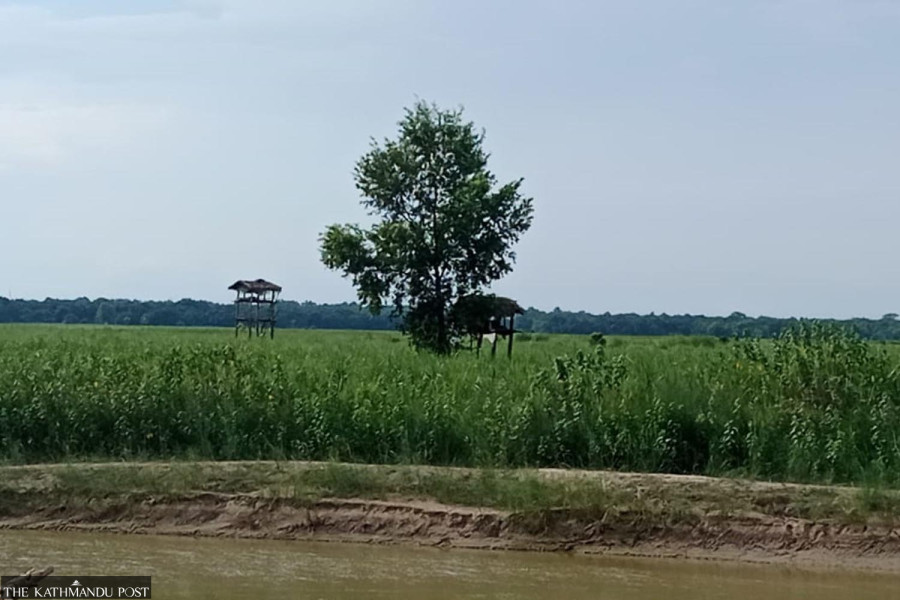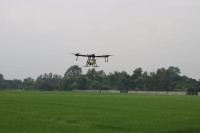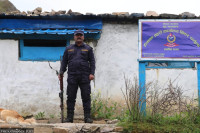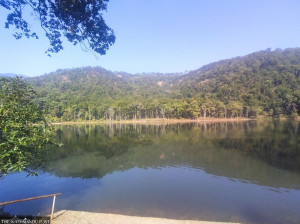Sudurpaschim Province
Kanchanpur farmers risk life sleeping in the field to protect crops from Shuklaphanta animals
They alert each other and bang wood on metal sheets to scare away wildlife, but past incidents show these makeshift defences are not foolproof.
Bhawani Bhatta
Sixty-year-old Jhikadu Rana of ward 5 of Imilia in Beldandi Rural Municipality rarely spends his nights at home. This has been the routine not just recently, but for the past 15 years. Most of the time, his nights are spent in his fields across the Chaudhar river. To protect his crops from wild animals, he keeps watch there at night.
Rana has built a wooden watchtower, known as machan, in the middle of his farmland. In the evenings, after having dinner at home, he crosses the river and heads to the tower, where he sleeps under a thatch roof. Rana owns two bigha [1 bigha = 0.68 hectares] of land, where he has planted sugarcane. It is this sugarcane that draws elephants, rhinos, wild boars, and spotted deer from the Shuklaphanta National Park. From his machan, he stands guard to chase them away.
Like many farmers of Imilia village, Rana has devised a simple alarm system: tin containers fixed on the edge of the fields, connected with ropes that stretch up to his watchtower. When wild animals approach, he pulls the ropes to strike wood against the tin, hoping the noise will scare them away. “Even then, half of the crop is eaten,” he says. “During the monsoon, crossing the river is hard, and once I reach the tower I fear snakes and other animals lurking in the dark.”
Imilia lies east of the Chaudhar river while Radhapur, the farming site, lies to the west. The settlement itself is tiny—just four or five families live amid the farmland bordering the national park. Locals call it “72 bigha,” the name sticking since the government’s land survey years ago measured the cultivated patch at that size. Almost every plot here has its machan, and villagers have turned them into their makeshift shelters at night.
For 53-year-old Bisna Chaudhary, sleeping in the fields has also become a decade-long routine. His half–a-bigha plot of sugarcane lies in Radhapur, where she says more than a dozen watchtowers dot the landscape. “We all return home only after sunrise,” he said. “If someone falls sick or an emergency arises at night, we must use inflated tubes to cross the flooded river. It’s risky, but there is no alternative,” he lamented.
Farmers say elephants pose the greatest threat. They crush and eat sugarcane, sometimes destroying entire patches in a single night. Wild boars also tear through stalks. Rhinos and deer nibble mostly on leaves, causing less damage but still trampling the crops. “A rhino may spend the entire night in the fields,” said Rana. “It doesn’t eat much, but just moving around causes heavy loss.” Because almost every family has planted sugarcane, elephants are frequent visitors.
The nightly vigil is coordinated. When animals are spotted, farmers call each other, then bang wood against metal sheets to create a raucous din. Yet, as past incidents have shown, such defenses are far from foolproof. In many parts of the Tarai, elephants have toppled watchtowers, leaving farmers injured or dead. Conservationists have long warned that farmers are risking their lives by confronting animals with nothing more than noise and fire.
Shuklaphanta National Park, a biodiversity hotspot, shelters more than 3,000 swamp deer, over 40 tigers, rhinos, leopards, and migratory birds. But for bordering communities like Imilia and Radhapur, living so close to the park means a constant struggle between conservation and survival. Human-wildlife conflict has steadily worsened, with elephants alone killing dozens across the Tarai in recent years. Compensation schemes exist but are slow and inadequate, leaving farmers frustrated.
Radhapur’s farmers also face another challenge: the Chaudhar river. In the monsoon, it swells, eroding land and cutting off safe passage. What remains of the farmland is guarded under the dim light of mobile phones or lanterns, the men sleeping in towers while women join during the day to collect fodder and chase away animals.
“We are squeezed between the river and the jungle,” complains local farmer Manamati Rana, who has planted sugarcane in her half-a-bigha of land across the river. According to her, the wild elephants frequently visit the farmlands to devour sugarcanes.
The practice of guarding fields has become a generational habit in Tarai, where subsistence farming depends on crops that happen to attract wildlife. While officials praise community resilience, they acknowledge the system is unsustainable. Calls for stronger electric fencing, alternative crops, and improved compensation have been made repeatedly, but implementation has lagged.
For now, farmers like Jhikadu Rana continue their long, sleepless nights in fragile wooden towers. “If an elephant pushes this down, we have no chance,” he admits. “But leaving the crops unguarded means losing everything. So we stay here, night after night.”




 9.12°C Kathmandu
9.12°C Kathmandu











%20(1).jpg&w=300&height=200)

